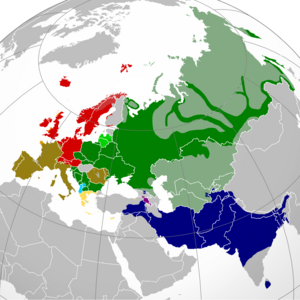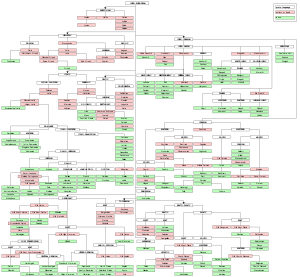Classical Mythology/Indo-Europeans
 Non-Indo-European languages Dotted/striped areas indicate where multilingualism is common.One source for Greek mythology may be the combined mythologies of the people often called Indo-European or, more accurately, Proto-Indo-Europeans. The term and its application to a people, a culture, and mythology is debated, but it is important to know the basic outline of the theory. The summary is that linguistic evidence indicates that Greek, Latin, Iranian, German, and many other languages descended from an extinct common original language. Perhaps comparing the myths in these different cultures can help reconstruct an Indo-European mythology that has formed the basis for some stories. Reconstructing the Indo-European LanguageeditLinguistically, Indo-European is a language family of interrelated languages that presumably can be traced back to a common ancestor. The linguistic evidence for the ancient ancestor common language is very strong, but the exact details of its reconstruction and its implications for a original people and culture are debated. Members of the Indo-European language family include these major groups:
How do we know these languages are related? The linguistic evidence of regular sound changes shows that these language families branched off from an ancestral language. The older the documented evidence, the more similar the languages are. Before presenting the evidence for the Proto-Indo-European language, consider this evidence for a more secure historical evolution, the transformation of Latin into the Romance languages, such as Romanian, Portuguese, Spanish, Italian, French:
These words were picked more or less at random, but the focus was on words that tend to be conservative and not borrowed from other languages. Numbers, words about family members or body parts tend to be conservative. The sounds shift generally following simple rules, depending, for example, on whether the sound is in an emphasized syllable or not. Even though there are often gaps in the documentary record for how Latin words changed into the Romance languages, historical linguistics is able to explain the whole transition convincingly. Similarly, looking at conservative words from early representatives of each of the Indo-European family reveals that the languages are closely related. Here is a list of the different terms for the first 10 numbers in various Indo-European languages: Indo-european cardinal numbersedit
 Scholars used this data and tens of thousands of other words to reconstruct the sounds and grammar of the original language, which they call Proto-Indo-European (PIE), or often colloquially as just Indo-European[3] Based on the reconstructed language, scholars have been able to figure outIndo-European sound laws to explain sound shifts from the original language to the sub-families, such as Germanic, Slavic, or Italic. While historical linguistics cannot predict how sounds will evolve in a speech community, it can explain and quantify the changes in rules that are surprisingly consistent. The earliest such rule is called Grimm's law, which explains how some original Indo-European consonants like K persist in most languages such as Latin and Greek, but are changed in the Germanic languages. The bulk of evidence was put together already in the 1800s, and proves that languages from Ireland in the West to Iranian Hindi in the East were originally descended from a common ancestor language. That conclusion is not controversial. Who spoke this language, where they spoke it, and when it was spoken are tougher questions to answer, and the topic of the next section. Reconstructing Indo-European HistoryeditWho spoke the Proto-Indo-European language? Where was it spoken? When was it spoken? There is no scholarly consensus on these questions. Perhaps the easiest question to tackle would be the question of time frame. We can estimate the time when Proto-Indo-European was spoken by looking at the earliest documents in descendant languages, which show that languages had branched off considerably by 1500 BCE. Probably there was a Proto-Indo-European speech community between 4000 and 2500 BCE, but it is difficult to say how far back it formed and exactly how long it held together before the languages broke off and went their separate ways. The archaeological record gives some clues, since the reconstructed Proto-Indo-European vocabulary includes technology words such as yoke, axle, and wheel. The vocabulary also includes words for domesticated animals, agriculture, and metallurgy (silver, gold, and bronze. These clues indicated that the Proto-Indo-European speech community did not diverge into separate branches before 4000.  Some guesses can be made based upon the locations of the earliest attested languages, such as Hittite in modern-day Turkey. Some guesses can be made based upon the reconstructed Proto-Indo-European vocabulary. It did not seem to have a word for sea or ocean. It had words for bear,wolf,horse,salmon, eel, fish, and many other animals. The most often proposed sites for an "original Proto-Indo-European homeland" have been:
It is hard to connect archaeological remains with a specific linguistic community if there is no written evidence. The evidence does suggest that the Western Indo-European language families (Celtic, Italic, Germanic, and Hellenic) came to their historical locations in Europe relatively late. It is important to distinguish between a linguistic community and linguistic families and genetic communities and families. The story of how Indo-European language families arose is often simplified as a migration and separation of peoples. For example, "One group of Proto-Indo-Europeans walked southeast, and after a few hundred or thousand years their language became the ancestor of the Indian and Iranian branches. Many languages develop by precisely those methods, but not all. Consider cases of historical linguistics where we know more of the evidence. The Langobards (Long Beards), Ostrogoths (East Goths), Franks, and Vandals were Germanic tribes that conquered parts of the Roman Empire. Over time, their languages blended with the local Latin dialects and became Romance languages such as Spanish, Italian, and French. Later Germanic tribes of Angles, Saxons, Danes, and Norsemen invaded England and Northern France. In English, the Latin and Celtic languages lost to the Germanic language. In France, the Norsemen became French-speaking Normans, who invaded England and changed the English greatly but it still remains a Germanic language. Later, these Englishmen and other Britons went on to conquer India and import its language there. Today, Indian English has over 100 million speakers and enjoys the status of an official language. However, these speakers are (mostly) not genetic descendants of the original colonizers. In other words, these examples show the variety of ways languages and cultures can spread, either with a genetic population or by other means. Many scholars trace certain aspects of Greek myth and ritual to reconstructed earlier Proto-Indo-European myths and rituals. Regardless of the validity of these cultural connections, it is important to distinguish between a cultural link and a genetic link. We cannot say that the Greeks of historical times were genetically Proto-Indo-European, even in part. There are some attempts to link modern genetic traces with prehistoric ancestry, but it is best to be sceptical.
Referencesedit
|